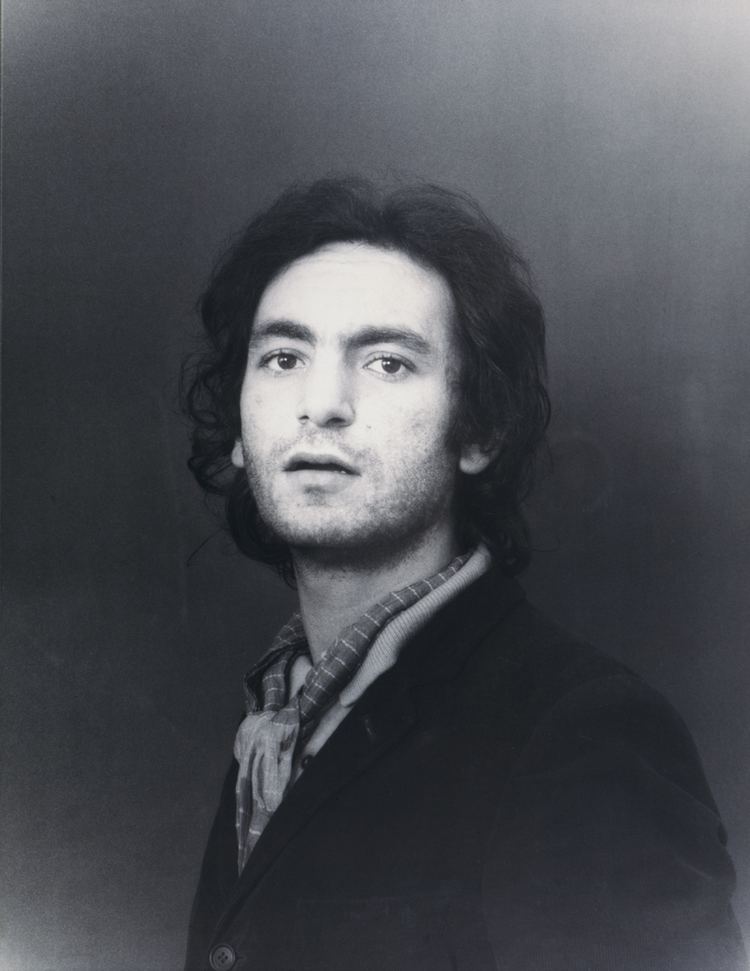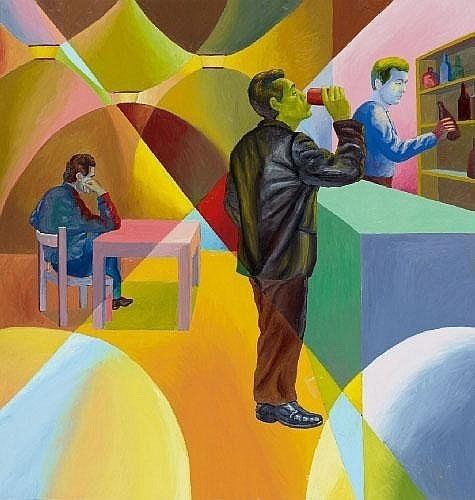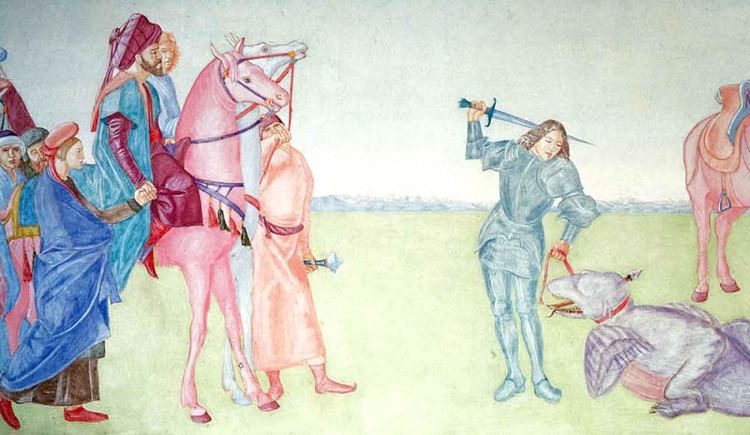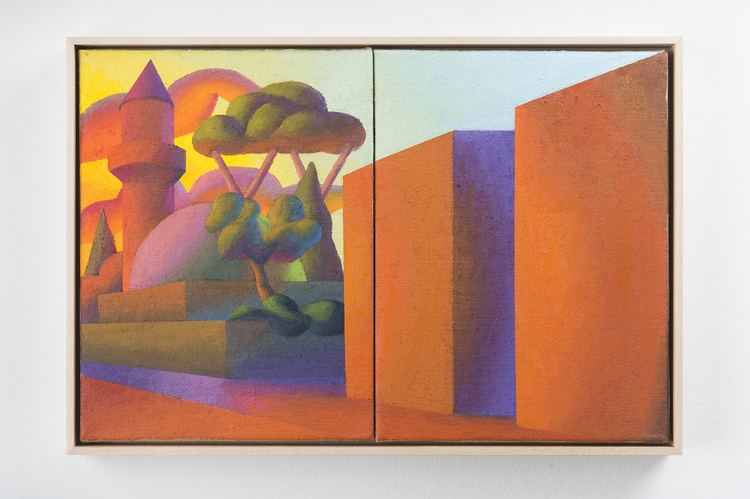Name Salvatore Mangione Role Artist | ||
 | ||
Died September 12, 2015, Turin, Italy | ||
Ouida salvo artist
Salvatore Mangione, known as Salvo (22 May 1947 – 12 September 2015), was an Italian artist who lived and worked in Turin.
Contents

Biography

Salvo was born in Leonforte in 1947. After having spent his early childhood in Sicily, in 1956 he and his family moved from Catania to Turin. In 1963 he participated in the 121st exhibition of the Società Promotrice delle Belle Arti. He painted and tried to sell portraits, copied from Rembrandt and Van Gogh and from Fontana to Chagall.

From September to December 1968, he was in Paris, drawn by the cultural climate that flourished around the student movement. Back in Turin, he began to meet with a group of young artists involved in the Arte Povera, that gathered around Gian Enzo Sperone's gallery in Piazza Carlo Alberto. Here, he met Alighiero Boetti, with whom he would become friends, as well as Mario Merz, Gilberto Zorio, Giuseppe Penone and art critics such as Renato Barilli, Germano Celant and Achille Bonito Oliva. In 1969, he had contact with American conceptual artists Joseph Kosuth and Robert Barry, and he also met Sol LeWitt, who would buy some of his works, including the "Occupazione del sapiente letterato (Occupation of the wise man of letters)" tombstone.

In the summer, he traveled extensively through Afghanistan. He engaged in works that already display certain tendencies of his – the search for himself, narcissistic self-gratification, relationships with the past and with the history of culture – which would all become important themes of his subsequent research. In the "12 autoritratti (12 self portraits)" series, he used photomontages to apply his face to pictures clipped from newspapers.

Concurrently with his photographic work, Salvo produced marble tombstones on which he engraves words or phrases, such as "Idiota (Idiot)", "Respirare il padre (To breathe the father)" and "Io sono il migliore (I am the greatest)". Despite their belonging to an Arte Povera context, these works reveal, through their monumental and archaizing connotations, a certain nature that is totally unique and a forerunner of his future work. "Salvo è vivo (Salvo is alive)", currently at the Australian National Gallery in Canberra, dates back to 1970, while "40 Nomi (40 Names)", a list of illustrious characters from Aristotle to Salvo, to the following year. The tombstone series continued through 1972 with inscriptions drawn from a variety sources, such as an Assyrian text in Il lamento di "Assurbanipal (Assurbanipal's lament)", or a fable by Aesop for "La tartaruga e L'aquila (The turtle and the eagle)". In 1971, he produced "Tricolore (Tricolour)" – surfaces on which "Salvo" is written in white, red and green, or with neon letters – beside copies of books, transcribed by himself, where he re-proposes the same substitution process adopted for his self-portraits, replacing the names of the protagonists with his own. In the same year, he was introduced to Paul Maenz by Robert Barry. It was the beginning of a long friendship with the German art dealer, who held a very successful solo exhibition of Salvo's works in June at his gallery in Cologne, preceded by Salvo's debut in Paris, at the Galerie Yvon Lambert. In June 1972, he met John Weber. Arrangements were made, in this occasion, for what would be the final exhibition of Salvo's conceptual works, in the following year at Weber's gallery in New York. Also in 1972, Salvo exhibited his work in Documenta 5 in Kassel.

1973 was the year of his artistic turning point, in the sense of a return to painting through the recovery of its traditional techniques, which had already been foreshadowed in some of his "Autoritratti benedicenti (Blessing self portraits)" of 1968 and 1969. In the aim of revisiting art history, Salvo went on with his series of d'après, which he commenced in 1970 with his "Autoritratto come Raffaello (Self portrait as Raphael)". Reference to masterpieces of the past does not imply just pure copying, but a simple and ingenuous remake in which, at times, the artist may find the way of including himself through the narcissistic practice of self-portrayal. In December 1973, his recent works, inspired by great masters of the fifteenth century such as Cosmè Tura and Raphael, were on display in different shows. The following year saw the inauguration of the important art show "Projekt '74" in Cologne. Salvo requested his works not be shown in the Kunsthalle, the venue of the exhibition, but in a hall of the Wallraf-Richartz-Museum, where his "San Martino e il povero (Saint Martin and the pauper)" of 1973 was placed next to masterpieces of painters of different centuries, such as Simone Martini, Lucas Cranach the Elder, Rembrandt and Cézanne. He then painted his first "Italie (Italies)" and "Sicilie (Sicilies)"; these are easily identifiable geographic maps bearing the names of illustrious philosophers, artists and musicians that precede that of Salvo, himself, in the orderly scan of the surface of the works.
A new phase of his research began as of 1976. He conceived a series of landscapes in which he portrays, through a simplified approach, and loud colours, in a subsequent moment, horsemen in the midst of architectural ruins, and visions of barely-standing classical columns, seen at various times of day, between dawn and dusk.
The following January, for the first time, a museum hosted a retrospective exhibition dedicated to him. Curated by Zdenek Felix on behalf of the Museum Folkwang in Essen, the exhibition then moved on to the Mannheimer Kunstverein in Mannheim. Between the end of 1979 and 1980, Salvo painted a series of landscapes with country homes, churches and monuments, such as San Giovanni degli Eremiti in Palermo and the Tower of Pisa, in which trees of clear Giotto inspiration, and almost inexistent vegetations make their appearance. That year he also produced the book On Painting – In the style of Wittgenstein, a collection of 238 short paragraphs in which Salvo discloses his thoughts through axioms and rhetorical questions. The booklet is published in Italian, English, German and Spanish.
The years 1982 and 1983 saw a further consolidation of his fame in Europe. Following the extensive retrospective exhibition organized by Massimo Minini in March 1982 at the Museum van Hedendaagse Kunst in Ghent, in the year after, his most significant works since 1973 were exhibited at the Kunstmuseum in Lucerne, and immediately afterwards at the Nouveau Musée in Villeurbanne, near Lyon. In 1984, Maurizio Calvesi invited Salvo to participate in "Arte allo specchio", an exhibition organized for the 41st Venice Biennale. Salvo contributed six works, including "San Martino e il povero (Saint Martin and the pauper)", "Il bar (The café)" of 1981, and a painting of the "Rovine (Ruins)" series, which he took up again that same year. After his return from a long trip to Greece, Yugoslavia and Turkey, he painted the "mishrams", the characteristic Muslim tombs he saw in Sarajevo. This theme, presented by Franco Toselli, was followed up by "Ottomanie" (a neologism of Salvo's), variations on his previous monumental landscapes, in which minarets appear in all their structural essence, against a backdrop of imaginary cities, or captured in evocative nocturnes. Eva Menzio introduced him to Daniele Pascali, who would become his exclusive dealer from 1987 to 1995. From the 1990s until his death in 2015, Salvo dedicated a series of paintings to locations he has visited, such as Arab countries (Oman, Syria, the United Arab Emirates, etc.), Tibet, Nepal, and Ethiopia, besides many European countries, especially in the north.
Starting in 1995 Salvo spent several months each year at his house on the Gulf of Policastro and at his mountain cottage at the foot of Monviso, locations that have inspired many of his works. In 2005, after a short break, he embarked on a new pictorial research project: an attempt to turn away from valleys, his favourite subject in the last years, and direct his focus to planes, introducing a new perspective to his landscapes. In the summer of 2006, he traveled to Iceland, a country to which he dedicated a series of paintings.
In 2007 Turin, his home city, dedicated to him a big anthological show at Galleria d'Arte Moderna e Contemporanea, curated by Pier Giovanni Castagnoli.
Beginning in 2008 Salvo split his time between Turin and Costigliole D'Asti, in the countryside between Langhe and Monferrato, where he took inspiration from the beautiful landscapes.
Exhibitions
The artist's collaboration with commercial galleries began in 1970 with a first solo show of Salvo's work occurring at the Galleria Sperone in Turin in that year.
During the 1970s he worked with many Italian galleries (Galleria Françoise Lambert, Milan; Galleria Marilena Bonomo, Bari; Galleria Toselli, Milan; Galleria Banco, Brescia; Galleria Christian Stein, Turin; Galleria Massimo Minini, Brescia), and foreign galleries as well (Galerie Paul Maenz, Cologne; Yvon Lambert, Paris and Art & Project, Amsterdam).
From the 1990s on Salvo has been represented by galleries Toselli, Milan; Raffaelli, Trento; Zonca e Zonca, Milan and Mazzoleni, Turin. Since 201 his work has been shown by and at Galleria Mazzoli, Modena and gallery Mehdi Chouakri, Berlin.
The opportunity to show in a museum first arrived in 1977, when his first anthological exhibitions were held at the Folkwang Museum, Essen, and at the Mannheimer Kunstverein, Mannheim. From 1982 to 1988 solo shows were organized in different public institutions in Italy and abroad: Museum van Hedendaagse Kunst, Ghent (1982); Kunstmuseum Luzern, Lucerne (1983); Le Nouveau Musèe, Villeurbanne, Lyon (1983); Kunstverein Laupheim-Schranne, Laupheim (1987); Museum Boijmans Van Beuningen, Rotterdam (1988) and Musée d'Art Contemporain, Nîmes (1988).
Recent solo shows of his work have been held at Galleria dello Scudo, Verona (1992); Galerie der Stadt, Stuttgart (1994); Galleria D'Arte Moderna, Bologna (1998); Galleria d'Arte Moderna e Contemporanea, Bergamo (2002); Ulm Kunstverein (2004); and Galleria Civica d'Arte Moderna e Contemporanea, Turin (2007). In 2014 Salvo had a solo show at Mehdi Chouakri, Berlin.
Group exhibitions are numerous since his participation in 1963 in the 121° Esposizione Sociale at Promotrice delle Belle Arti in Turin, and include presentations at institutions in Italy and abroad, taking part in some of the main international exhibitions of Italian art and in many shows dedicated to the artistic development of the 1970s and 1980s:
In 2013 Salvo participated in the show "Gli anni Settanta" at Palazzo delle Esposizioni in Rome and at "Quarantanni d’arte contemporanea. Massimo Minini 1973 - 2013" at the Milan Triennale.
In January 2014, Salvo had a solo show at the gallery Mehdi Chouakri, Berlin.
Salvo died in Turin on 12 September 2015 at the age of 68.
